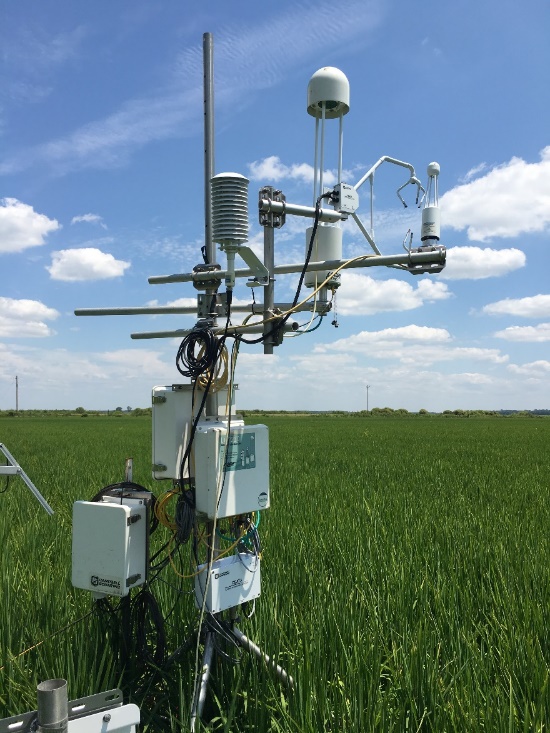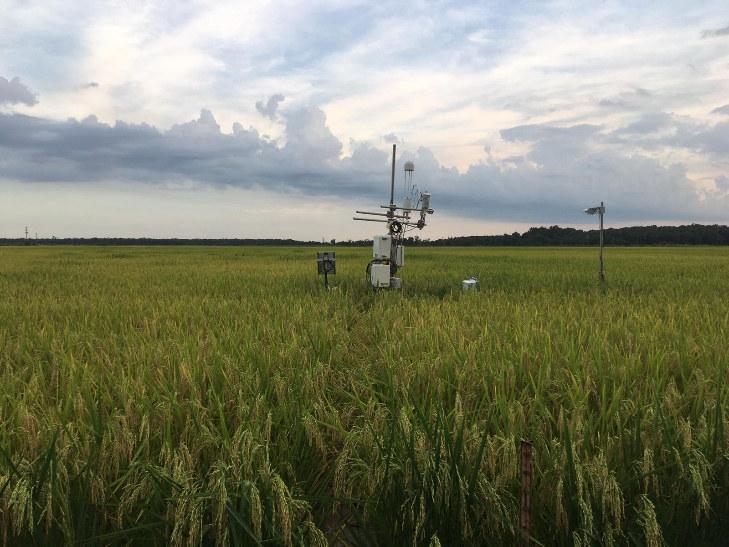Rice can be grown with a lower climate impact
The Science
Rice is a critical crop to feed humanity, but its production in water-logged field environments spurs methane production that is responsible for 11% of the anthropogenic contribution of methane to the atmosphere. These greenhouse gas emissions can be reduced from rice production through the deliberate introduction of dry periods in the growing season. Researchers at the University of Arkansas and USDA Agricultural Research Service quantified these reductions at the field scale, determining that this alternative irrigation practice can reduce methane emissions by 64.5% without limiting the rice harvest. They measured these emissions on a pair of adjacent fields at the Humnoke Farm under different irrigation management practices throughout three growing seasons using a technique called eddy covariance. They have contributed this data (US-HRA and US-HRC) to the AmeriFlux network, standardizing similar measurements in the Americas in different agricultural or ecological environments.
The Impact
These results will be used to encourage adoption of water-saving irrigation practices that also reduce greenhouse gas emissions from rice fields. Already incentivized by the Natural Resources Conservation Service, the practice can also qualify for carbon-emissions offset credit. The science has now shown that the method succeeds at the field scale, and not only on a field trial or pot experiment. This proof in a real farmer’s field will help spur other rice producers to implement this practice. There is now the opportunity to produce rice for our expanding global population while reducing the burden of this production on our atmosphere’s greenhouse gas composition.
Summary
Rice agriculture is responsible for about 2% of the nation’s greenhouse gas emissions from agriculture, in large part due to the methane produced with rice fields are flooded for extended periods. In those conditions, without oxygen in the soil layers, methane–a greenhouse gas more potent than carbon dioxide–can form and be transported to the atmosphere. By interrupting these anaerobic conditions, the alternate wetting and drying irrigation strategy reduces methane production and emission. This study uses a state-of-the-art method, eddy covariance, to measure the turbulent exchange of methane and other gases between the rice landscape and atmosphere. Measuring emissions on adjacent fields over three growing seasons where different management practices were employed enables the researchers to quantify the degree to which this irrigation practice can reduce methane production. Since they also measured rice yield, the research demonstrates that this practice can be performed without affecting rice harvest even while it reduces methane emissions by 64.5%. If this practice can be widely implemented by rice farmers it offers a key step toward a sustainable rice production system. The research team is now using an extra measurement system provided by the AmeriFlux Management Project, through its Rapid Response Flux System Program, to test the practice on different soil and cultivation conditions on a third rice field (US-HRN).

A Rapid Response Flux system was setup in early July 2019 at the Humnoke Farm in Arkansas (US-HRN), measuring methane dynamics of a rice field (photo credit: Anthony Zadoorian)
Contact
Benjamin R. Runkle, Assistant Professor, Department of Biological & Agricultural Engineering, University of Arkansas, Fayetteville, brrunkle@uark.edu; www.twitter.com/DrBenRunkle
Funding
This work was funded through the U.S. Geological Survey under Cooperative Agreements G11AP20066 and G16AP00040 administered by the Arkansas Water Resources Center at the University of Arkansas, the USDA-NRCS under Cooperative Agreement 68-7103-17-119, and the NSF under award no. 1752083. Additional support came through the ARS Participation Program administered by the Oak Ridge Institute for Science and Education (ORISE). ORISE is managed by Oak Ridge ORAU (DE-AC05-09OR23100).
Publications
Runkle BRK, Suvočarev K, Reba ML, Reavis CW, Smith SF, Chiu Y-L, Fong B, (2019), Methane emissions reductions from alternate wetting and drying of rice fields detected using the eddy covariance method, Environmental Science & Technology, 53(2), 671-681, doi:10.1021/acs.est.8b05535, online.
Ben Runkle authored this post for the AmeriFlux Rapid Response Flux System Program.


No Comments
Be the first to start a conversation